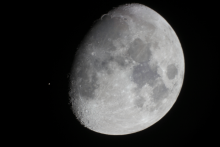Listen to today's episode of StarDate on the web the same day it airs in high-quality streaming audio without any extra ads or announcements. Choose a $8 one-month pass, or listen every day for a year for just $30.
You are here
Venus and Aldebaran
The “morning star” and the eye of the bull are staging a brilliant encounter in the dawn sky. They’ll be quite close to each other for about a week, providing plenty of time to see them.
At first light tomorrow, Venus, the morning star, will stand directly above Aldebaran, the star that marks the eye of Taurus. Over the following few days Venus will slide down to the left of Aldebaran, then stand side by side with it. After that, Venus will drop away from the star, with the gap between them getting wider each day.
Although Venus looks brighter, that’s only because it’s much closer to us than Aldebaran is. If you lined them up at the same distance, Aldebaran would look billions of times brighter.
That indicates that they’re completely different kinds of objects. Venus is a planet about the size of Earth. It doesn’t “shine” on its own. Instead, sunlight reflects off the clouds that top its atmosphere. The combination of the clouds and Venus’s proximity to both Earth and the Sun makes it look bright.
Aldebaran is about nine million times farther than Venus is this week. But it’s a star, and a big one at that — about 40 times wider than the Sun, and five thousand times the size of Venus. Nuclear reactions in its core produce energy. By the time it reaches the star’s surface, much of that energy is in the form we see with our eyes — the beautiful glow of a giant star.
Tomorrow: another pairing in the early morning sky.




